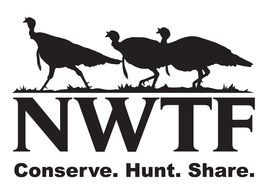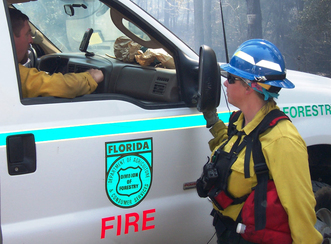|
By Peter Kleinhenz
I
recently updated my wardrobe, a rare event for my 27-year-old self and an event
that may seem trivial in an article about Wildlife Management Areas. But this
isn’t a story about a new pair of jeans, enticing as that may be. Rather, it’s
a story about a bird and why that bird, in many ways, represents the future of
conservation in Florida.
 Wild turkeys, photo by David Moynahan
You
see, my new wardrobe consists of pants, gloves and a hat, all camouflaged, in
addition to a type of leafy blanket to cover my body. It is, after all,
essential to become invisible when pursuing one of the key game animals in
Florida: the wild turkey.
The wild turkey will probably never win any beauty awards. Besides the broad tail fan and patriotic head coloration possessed by males, they are basically plain-plumaged, fat birds. It’s their size, though, that has ensured their place as a sought-after game animal and staple of the American diet.
 Turkey hunters, photo by Tim Donovan, FWC
Now,
it’d be one thing if wild turkeys just stood there waiting to be harvested. But
they’ve evolved keen senses to evade pursuit. One glimpse of a hunter
and they’re gone. It’s this challenge that motivates the hunting community.
 |
|
Habitat
loss and overhunting dramatically reduced turkey populations in the early 20th
century. Partnerships have been key to restore this much-admired bird. The National Wild Turkey Federation
(NWTF), for example, works throughout the U.S. to restore turkey numbers. Ricky
Lackey, district biologist for the NWTF in Florida, emphasized why the work
they do matters so much.
|
“We help public and private managers in the state improve habitat for, really, all upland species,” Ricky told me. “Turkeys are a focus but we’re doing a lot of work that benefits most upland game and nongame species.”
The restoration work consists of management techniques meant to bring back natural communities and the species found within them. The only problem is that NWTF is a nonprofit and one that does not own land. They must work with those who manage enormous tracts of land to achieve their goals, such as the Florida Fish and Wildlife Conservation Commission (FWC).
“We can’t do the work that we
want to do without state agencies,” explained Ricky. “We’re just a nonprofit so
to have a partner like FWC is crucial, it’s critical. We could not even come
close to making the impact we do without them.”
 Recovery after a prescribed burn at Triple N Ranch WMA, photo by David Moynahan
David Johnson, section leader of the Wildlife and Habitat Management section of FWC, echoed this sentiment.
“We have 5.9 million acres in the Wildlife Management Area system. We’re not lead on all of that acreage, but we’re involved in that and we have a very limited staff that can do things on the ground and, so, there’s a lot of things to be done. And we can’t do it alone. We just can’t.”
Prescribed
burning, for example, is a major undertaking involving many agencies. Those who
manage turkey populations know how important it is to do, and to do on a
massive scale to increase turkey numbers.
“Fire has shaped the landscape
in the Southeast over thousands of years,” Ricky Lackey stated. “Without fire,
hardly any native species would be as prevalent as they are, if they were here
at all. Prescribed fire is essential for robust wildlife populations.”

The Florida Forest Service (FFS)
which oversees all Florida burns, set the all-time record for most acreage
burned by one state agency back in 2014. To Jim Karels, FFS director and a
turkey hunter himself, restoring landscapes via fire and partnerships go
hand-in-hand.
|
Florida Forest Service burn crew
“That partnership on WMAs for prescribed fire, whether it’s our land, or whether it’s FWC land or whether it’s somebody else’s land…that prescribed fire interlinks all of us."
The
number of acres burned as a result of these partnerships continues to rise. On
a recent turkey scouting excursion to a local WMA, low grasses and blooming
flowers pierced the blackened ground in all directions. The habitat looked
promising for my upcoming hunt. Like good hunting guides, the aforementioned
partners have put me and many others in a good position this spring turkey
season. But, now, it falls on my shoulders to complete the next step.

See
if I end up bagging a turkey in part two of this two-article series, coming
next week. In the meantime, check out opportunities near you to hunt
or view turkeys, along with a
suite of other wildlife species on FWC Wildlife Management
Areas. April is also a great time to view other results of WMA
partnerships, such as restored
habitats full of wildflowers
and pollinators,
and to participate in our 75th
anniversary events such as the spring
photo contest and geocaching
challenge. Earth Day is coming up too, so don’t miss our “Welcome
to the Woods” event held on April 22 at Seminole Forest WMA.
|